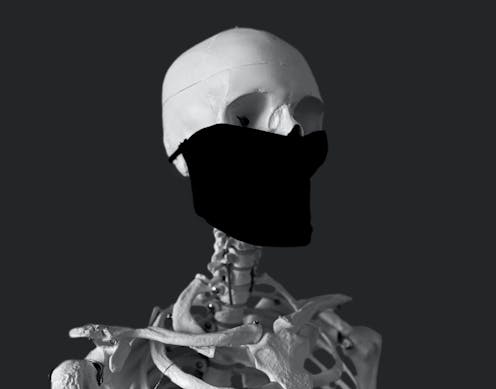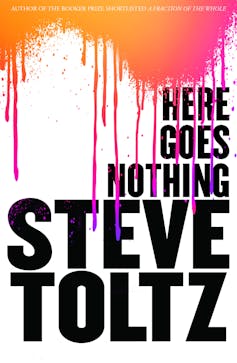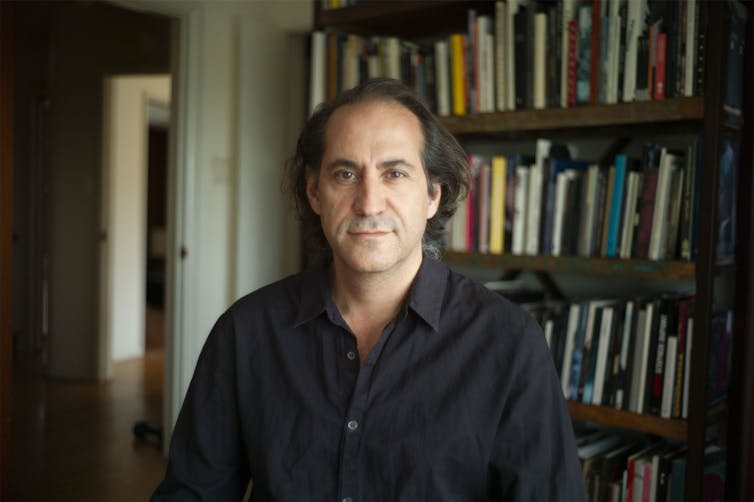
The afterlife, as depicted in Steve Toltz’s latest novel Here Goes Nothing, turns out to be somewhat disappointing. There are no heavenly rewards or seething lakes of fire. If there are any reunions with lost family and loved ones, then they occur by happenstance and can be rather awkward. The suffering – of which there is still plenty – does not result from divine or cosmic justice and lacks any kind of satisfying irony. Life after death, it turns out, is just another life.
Review: Here Goes Nothing – Steve Toltz (Hamish Hamilton).

Here Goes Nothing is narrated by the recently deceased Angus Mooney, a reformed petty criminal and ardent atheist, who is alarmed and faintly embarrassed to find himself in this underwhelming afterlife. Thrust into a new world that seems every bit as arbitrary as the one that preceded it, Mooney must struggle to navigate its unwelcoming culture, while also finding a way to contact his wife, Gracie, who is still alive and contending with both an unexpected pregnancy and a deadly pandemic that is threatening to make its way to Australian shores.
More problematically, from Mooney’s perspective at least, Gracie is unknowingly cohabiting with his murderer, Owen Fogel, a dying doctor who had convinced Mooney and Gracie to allow him to spend his last months living in their house, which had been his childhood home.
There is a lot going on in Here Goes Nothing, from Mooney and Gracie’s tragic histories, to Owen’s enjoyably glib perfidy, to the surprising nature of the afterlife, to the potential extinction of the human race. Toltz keeps things moving at a brisk pace, with sections rapidly alternating between Mooney’s posthumous misadventures and Gracie and Owen’s experiences on the deteriorating mortal plane.
With its focus on a deadly epidemic, potential extinction, social upheaval, isolation, and increasingly oppressive restrictions (in both this world and the next), Here Goes Nothing can be understood as part of a growing wave of pandemic fiction, recently discussed by Lara Feigel in the Guardian.
Feigel divides pandemic fiction into two broad categories: those that offer realist accounts of life under COVID restrictions and lockdowns, and those that utilise the pandemic as a spark for imaginative speculation, considering how life might be transformed by similar disasters in the future.
Sequoia Nagamatsu’s recent novel, How High We Go in the Dark (2022), considers the ways in which the massive global fatalities from a resurgent prehistoric plague might transform the ways in which we manage death and mourning, and ultimately lead to societal and technological change. By contrast, a thread in Hanya Yanagihara’s latest novel To Paradise (2022) offers a dystopian vision of a totalitarian future that results from the uncontrollable spread of virulent plagues.
Toltz’s novel fits with this trend, bleakly satirising the ways in which an increasingly isolated Australia attempts to deflect awareness of the severity of a new, deadlier virus. In the afterlife, Mooney sees this extinction-level event manifest as a refugee crisis, with increasingly brutal and repressive measures taken towards the hordes of newly arrived deceased. In Here Goes Nothing, the world of the living and the world of the dead are both marked by cruelty, indifference, and an entropic slide towards chaos.
Magnificently ordinary
Toltz’s depiction of the afterlife is magnificently ordinary. After his sudden death, Mooney finds himself adrift in a muddy terrain of semi-derelict towns and villages, administered by a harried, ineffectual bureaucracy and surrounded by perpetually shifting borders and ceaseless conflicts between governments and rebel guerrillas. The technology is rusting and archaic, the plumbing is dreadful, the only reliable entertainment is community theatre, and there is no Wi-Fi.
In this regard, Here Goes Nothing is somewhat reminiscent of Will Self’s novel How the Dead Live (2000), where life after death is similarly presented as a prosaic downgrade: the dead simply move to a less fashionable suburb and continue much as they had before.
Toltz’s afterlife serves to underscore the arbitrary nature of existence as it is experienced by his characters. Death simultaneously fails to offer any expected closure or finality or satisfying answers to life’s mysteries.
Seemingly unfair or confounding afterlives have been subjects in fiction before – from the mysterious and unknowable City in Kevin Brockmeier’s The Brief History of the Dead (2006) to the horrific Null depicted in Stephen King’s Revival (2014) – but the deflatingly mundane world found in Here Goes Nothing feels particularly bleak. What follows death is not a judgement of a revelation, just more of the same.

Read more: In The Candy House, Jennifer Egan delivers an inventive novel for a digital age
An incomplete world
While inventive and thematically on point, Toltz’s afterlife feels frustratingly incomplete when viewed through the lens of speculative fiction. On one hand, it is too tangible to be taken as an allegorical conception of last things; on the other, it is not fleshed out enough to work as a fully realised secondary world.
Some aspects are described in elaborate detail – like the wonderfully clunky diesel-punk technology that is used in one sequence to propel Mooney’s spectre back into the world of the living – but its geography and culture are vague, and its politics and history are not satisfyingly explored.
Mooney is told, for example, that the afterlife has an indigenous population, who exist alongside the newly arrived deceased, but this is never mentioned again. We also never learn how so many familiar artefacts from our world can be present in the afterlife, where arrivals simply appear naked in a flash of light the moment after their death.
Mooney finds a stash of classic literature at one point – so do the dead somehow transcribe these books from memory? What happens to people who die from old age? Do they just die again after a few months living in the new world?
The lack of clear answers is partially justified in the novel. Mooney is not particularly interested in specifics and skips his orientation session. But this does occasionally feel like a bit of shortcut. In any case, the nature of the afterlife is a secondary concern, as Toltz is more interested in how his protagonists will respond to its disappointing reality than he is in exploring its exact workings.
While Here Goes Nothing doesn’t quite match the depth and wildness of Toltz’s extraordinary debut A Fraction of the Whole (2008), it does feel refreshingly focused when compared to his somewhat shapeless second novel Quicksand (2015).
Where Quicksand was structured as a loosely connected string of comic episodes in the life of its hapless protagonist, Here Goes Nothing is more purposeful. Despite the scale of the events and revelations that surround them, Toltz maintains a tight focus on his three central characters and their shifting relationships.
Read more: Review: Richard Flanagan's The Living Sea of Waking Dreams considers griefs big and small
Unfairness and inexplicability
The conflict between Mooney and Owen – which persists across life and death, right through the end of days and out the other side – reveals them as two characters who illustrate different responses to the unfairness and inexplicability of life and death.
Mooney, abandoned as a child and neglectfully raised within the Australian foster care system, embraces a weary, protective cynicism. He is incurious about the mysteries of life and afterlife. Owen, by contrast, is a bitter and often hilarious misanthrope, who enjoys watching things fall apart. Where Mooney is largely passive, Owen is defined by his restless questioning, gleefully probing at the boundaries of accepted belief, custom and behaviour.
Ironically, the only thing that keeps both men beyond the grip of nihilism is their shared fixation with Gracie, who provides them both with a sense of meaning and purpose. While it is initially quite easy to side with Mooney over Owen in their rivalry – Owen murdered him, after all – the events of the novel work to complicate this.
Once he has moved on to the afterlife, Mooney’s attempts to transcend the boundaries between the worlds and reconnect with Gracie – which could be framed as heroic and romantic – only serve to imperil her and their child, whereas Owen’s care for her ultimately positions him on something of a redemptive arc, one where he becomes somewhat capable of expressing sympathy and remorse, albeit in warped and disturbing ways.
As worlds and realities erode, Angus’s certainty of his superiority over his murderer becomes questionable, particularly regarding the possibly selfish claims that he attempts to make over Gracie from beyond the grave.
Read more: Witchcraft and fascism collide in Jane Rawson's imaginative new novel
Against the bleakness of existence
Gracie is the focal point not only for Mooney and Owen, but also for the novel itself. She functions as something of a rebuttal to the cynicism of the other characters and the bleakness of existence.
A bluntly spoken, iconoclastic marriage celebrant, who becomes an unlikely social media personality during the nightfall of humanity, Gracie persists in looking for meaning in the face of disappointment and disaster, apocalypse and tragedy. It is telling that though their wry perspectives dominate the tone of the novel, both Mooney and Owen are essentially orbital characters. Gracie’s actions and choices drive the plot.
Her perpetual struggle – with loss and grief, with pregnancy and the end of the world, and with Mooney and Owen – provides the novel with a faint, yet crucial thread of optimism, that mitigates the darkness of its absurd humour. This attitude is exemplified in her final decision at the climax of the novel, which resolves the cosmic love triangle between the three characters in a way that is simultaneously horrifying and oddly upbeat. Gracie’s refusal to accept the fact of a grim and uncaring reality is not presented as naivety, but as tough-minded and ultimately admirable defiance.
Here Goes Nothing will likely work to cement Toltz’s reputation as an exceptional comic writer. He is still, perhaps, a little too willing sacrifice consistent plotting and characterisation for the sake of a good line, and the universally sardonic, deadpan voices of his characters occasionally blur together. But the mordant humour is worth it.
Here Goes Nothing is very distinctively a Steve Toltz novel; its pleasures and flaws, and the trade-offs between them, will feel intimately familiar to existing fans of his work. For new readers, it may provide a more accessible entry point than his sprawling, ambitious earlier novels. If you are going to read just one new Australian novel this year – like me, possibly, at this rate – you could probably do a lot worse.
Julian Novitz does not work for, consult, own shares in or receive funding from any company or organisation that would benefit from this article, and has disclosed no relevant affiliations beyond their academic appointment.
This article was originally published on The Conversation. Read the original article.







